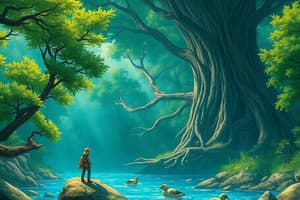Podcast
Questions and Answers
What is a predator?
What is a predator?
- An animal that hunts other animals for food (correct)
- A relationship where both species benefit
- An animal that eats plants only
- An organism that produces its own food
What is a consumer?
What is a consumer?
An organism that eats other organisms.
Define symbiosis.
Define symbiosis.
A close, long-term relationship between two species in which at least one organism benefits.
What is a herbivore?
What is a herbivore?
What is prey?
What is prey?
What is commensalism?
What is commensalism?
Define omnivore.
Define omnivore.
What is mutualism?
What is mutualism?
Define parasitism.
Define parasitism.
What is a food chain?
What is a food chain?
Define producer.
Define producer.
What is an ecosystem?
What is an ecosystem?
Define community.
Define community.
What is a population?
What is a population?
Define individual.
Define individual.
What does biotic mean?
What does biotic mean?
Define abiotic.
Define abiotic.
What is a primary consumer?
What is a primary consumer?
Define secondary consumer.
Define secondary consumer.
What are tertiary and quaternary consumers?
What are tertiary and quaternary consumers?
Define energy pyramid.
Define energy pyramid.
What are oppositional relationships?
What are oppositional relationships?
Define predation.
Define predation.
What is competition?
What is competition?
Define intraspecies competition.
Define intraspecies competition.
What is interspecies competition?
What is interspecies competition?
Define scavengers.
Define scavengers.
What are decomposers?
What are decomposers?
Flashcards are hidden until you start studying
Study Notes
Ecosystem Relationships
-
Predator: Hunts other animals for food, playing a crucial role in controlling prey populations.
-
Consumer: Organisms that rely on other organisms for energy, essential for ecosystem balance.
-
Symbiosis/Symbiotic Relationships: Involve long-term interactions between two species with at least one benefiting; essential for ecological dynamics.
-
Herbivore: Animals that exclusively consume plants, forming the primary consumers in food chains.
-
Prey: Organisms hunted, killed, and consumed by predators; vital for predator survival.
-
Commensalism: A type of symbiotic relationship where one species benefits and the other remains unaffected, exemplifying ecological interdependence.
-
Omnivore: Organisms that consume both plants and animals, playing a versatile role in food webs.
-
Mutualism: Interaction where both species benefit, such as bees pollinating flowers, promoting biodiversity.
-
Parasitism: Relationship where one species benefits at the expense of the other, often harming the host species.
-
Food Chain: Illustrates the flow of energy through various organisms; fundamental for understanding ecosystem interactions.
-
Producer: Organisms like plants that produce their food through photosynthesis, forming the base of food chains.
-
Ecosystem: Comprises living (biotic) and nonliving (abiotic) components interacting in a specific environment.
-
Community: Encompasses all populations of different species living in a shared environment, contributing to ecosystem dynamics.
-
Population: Refers to all individuals of a single species in a given area, important for studying species distribution and health.
-
Individual: Defines a single organism, representing the basic unit of ecological studies.
-
Biotic: Includes all living organisms, dead matters, and organic products within an ecosystem.
-
Abiotic: Pertains to non-living factors such as climate, soil, water, and minerals that influence ecosystems.
-
Primary Consumer: Organisms that consume producers; can be herbivores or omnivores, serving as a crucial link in energy transfer.
-
Secondary Consumer: Organisms that eat primary consumers; may include carnivores and omnivores, impacting population dynamics.
-
Tertiary and Quaternary Consumers: Higher-level consumers, with tertiary eating secondary consumers and quaternary feeding on tertiary, illustrating complex food webs.
-
Energy Pyramid: Graphical representation that demonstrates energy transfer efficiency through trophic levels, highlighting energy loss at each stage.
-
Oppositional Relationships: Negative interactions impacting both organisms involved, even if one appears to "win" due to resource acquisition, as it consumes energy and risks injury.
-
Predation: A straightforward form of interaction where one organism hunts and consumes another, shaping population dynamics.
-
Competition: Occurs when organisms vie for the same resources, leading to resource depletion and detrimental effects on both.
-
Intraspecies Competition: Competition within the same species, often for mates or territory, influencing evolutionary traits and behaviors.
-
Interspecies Competition: Competition between different species for shared resources, affecting biodiversity and niche differentiation.
-
Scavengers: Organisms that feed on dead animals, such as vultures, aiding in ecosystem nutrient cycling.
-
Decomposers: Microorganisms that break down waste and dead organisms, crucial for recycling nutrients and maintaining soil health.
Studying That Suits You
Use AI to generate personalized quizzes and flashcards to suit your learning preferences.




